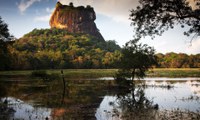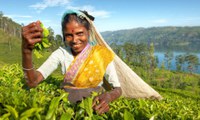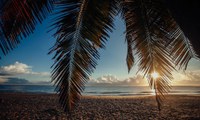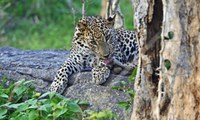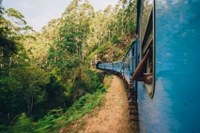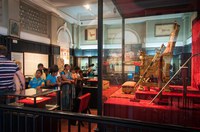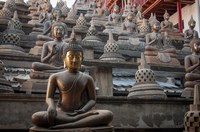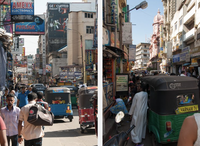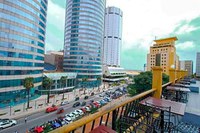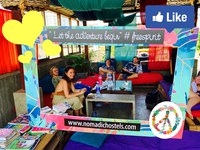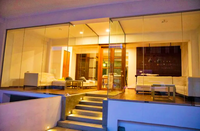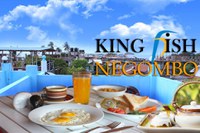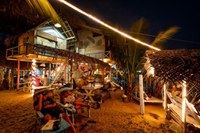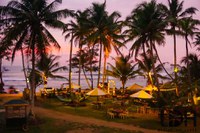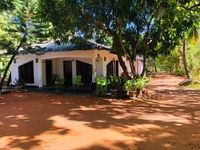One of Sri Lanka's seven UNESCO World Heritage Sites, this rock-top fortress dates back to the fifth century AD. The atmosphere is more spiritual than militant: in its time, it has acted as a royal palace and a Buddhist monastery. Sigiriya is also regarded as one of the most important urban planning projects of the first millennium, and is home to some of the oldest landscaped gardens in the world. Look out too for the mirror wall, a masonry wall that was so well-polished that the king could see his reflection in it. Top tip: go early, so avoiding the heat of the day and the crowds.
t the heart of Sri Lanka's tea industry, this charming throwback to the country's colonial years is rich with the heritage of home-county England. Tour neatly-terraced tea estates, watch pickers at work, and buy your own samples to take home. Tea lovers will want to visit the Hill Country’s Haputale Mountains, where Sir Thomas Lipton launched his tea empire. To see where it all began, organise transport to Lipton’s Seat – Mr Lipton’s favourite spot to sit and watch over his enormous estate. It is possible (and maybe a bit more comfortable) to take a car up, but an open air tuk-tuk ride is much more fun. Head out early before the afternoon fog cloaks the surrounding mountains, clouding the awe-inspiring views.
The beach at Arugam Bay, on Sri Lanka's dry south-east coast, is the stuff of Bounty ads are made of: sugar-soft sands, coconut palms and utter solitude but for the whoops and whooshes of the surfers riding the point. Before the 2004 Boxing Day tsunami, the bay was rapidly becoming one of the world’s top surf destinations. For the time being, you’ll have the double curve of beach and its coconut palm-covered point more or less to yourself, bar a few savvy sun-seekers.
Sri Lanka's alpha predator is protected in a number of national parks, but is most easily sighted in Yala National Park, on the island's southern coast, where you can cool off in the ocean after a day on safari. Yala National Park is Sri Lanka’s number one leopard sanctuary. The big cats are thriving here in territories of little more than a kilometre each – “the highest density in the world” – making seeing one almost a certainty. For those hoping to see a close-up leopard make its way down the tree and casually saunter through clearing to the cover of the bushes, then Yala National Park is undoubtedly the place to be.
Sri Lanka’s southern tip nudges the depths of the continental shelf. It’s an area favoured by blue whales and nowhere else does the world’s biggest creature swim so close to land, so reliably. Dondra Head is your jumping off point. From January to April, blue whales pass here on their route from the Bay of Bengal to the western Indian Ocean. They fill their bellies on the krill and squid that thrive in these waters, enriched by the outfall of Sri Lanka’s 103 rivers.
Built by the Dutch in 1663, the walled city of Galle, on the country's southernmost top and surrounded by ocean on three sides, is a must on any visit to Sri Lanka. Inside the fort, you’ll find Dutch Colonial buildings, ancient mosques and churches, museums and lots of quirky boutique cafés and restaurants. Outside, you'll be laying your eyes on some of the most beautiful beaches in Sri Lanka. Don’t forget to drop by nearby Koggala to see the famous stilt fisherman.Spotting them perched in the ocean on their frames - made from sticks and twine - is one of the most iconic and extraordinary sights in the country.
Long off the tourist trail, the city of Jaffna, in Sri Lanka’s formerly troubled Tamil north, is finally coming into its own. Its ancient fort is a delight to explore and far less crowded than Galle. Nallur Kandaswamy Hindu temple is a hive of devout worshippers and the markets are colourful, lively and the perfect introduction to local life in the north. Uncrowded beaches and islands are but a short hop away, too, as is Keerimalai Hot Springs, a popular bathing spot for curing all that ails you.
The one rail journey that features on almost every Sri Lankan itinerary, the three-hour trip from Colombo to Kandy will whisk you away from the big city sprawl to the genteel greenery of Sri Lanka’s spiritual capital, home to the legendary Temple of the Sacred Tooth Relic, enshrining what’s claimed to be a genuine tooth of Buddha. On the way, you’ll rattle past rolling hills, paddy fields, lush stands of tropical forest, palm trees waving like giant hands, and miniature village train stations with tin roofs and station attendants standing to attention in immaculate uniforms. You’ll also feel the air cool as you leave the baking coastal plain for the more pleasant climate of the hills. The Colombo to Kandy line was the first major route established by the newly formed Ceylon Government Railway in the 1860s, slicing through the forested hills inland from the capital to bring tea and coffee down to the coast, to further the economic ambitions of the British Empire. Today, travellers ride in the opposite direction, on a journey that serves as the perfect introduction to Sri Lankan train travel, and offers by far the most atmospheric and enjoyable way to reach the Hill Country from Colombo.
The trip from Colombo to Kandy is just a warm up for Sri Lanka’s most spectacular train ride: the British-era Main Line, built as a conduit for Sri Lanka’s most famous export – tea. The journey from Kandy to Badulla takes seven to eight hours, and carves through Sri Lanka’s tea country, passing swirling, curling plantations that appear hollowed into the hilly green landscape like the enormous fingerprints of a giant. Tidy fringes of lemongrass and canna bushes provide an ornamental trim around the edges, while tea-pickers in rainbow saris create vivid flashes of colour amongst the emerald sea. To make the most of the views, stake out a vantage point in one of the open train doorways, with your feet dangling above the track. The final stage from Ella to Badulla is perhaps the most dramatic section of the journey, with some spectacular feats of 19th-century engineering carrying the train across valleys and ravines and around problem outcrops. Just north of Ella, the tracks curve over the brick-and-stone Nine Arch Bridge before tackling the Demodara Loop, where the line circles a hilltop and passes back under itself. Many travellers end the journey at Ella and hike to viewpoints around the bridge, for one of Sri Lanka’s most popular photo opportunities.
The Indian Ocean washes almost up to the rail tracks on the ride south from Colombo to the Portuguese-founded city of Galle, bringing fresh breezes and the smell of sea salt right into the carriages. So long as you sit on the right-hand side of the train, you’ll have views out over the ocean as the train clatters out of Colombo. The rail line meets the shore just south of Galle Face Green, a large urban park on the outskirts of the capital, and follows it for almost the entire length of the journey. If the lure of the big blue gets too much, passengers can hop off the train at beachside towns including Moragalla (via Hettimulla station), with snorkelling opportunities amidst coral reefs, or Hikkaduwa, where surfers ride the swells and sip smoothies in shorefront cafes. Whether you choose to temporarily alight or not, make sure you sample the wares of vendors who join the carriages at tiny rural stations. Grab some buttered sweetcorn, sliced fruit or packaged curry and rice and take in the bucolic scenes of coastal life – from children and dogs splashing in the surf to stilt fishermen sat atop their wooden perch – all the way to Galle
The rail line to the far north of Sri Lanka was severed by fighting between southern Buddhists and Hindu Tamils during Sri Lanka’s long civil war. When the last Yal Devi Express rolled into Jaffna on 13 June 1990, it was marooned by bombing. Empty carriages were repurposed into military bunkers, tracks were ripped up for scrap metal and stations fell into ruin. For 25 years, rail travel to Sri Lanka’s Hindu north was a distant memory. And then, In 2014, the shrill whistle of locomotives returned to the north as the Yal Devi Express rumbled back into Jaffna, on gleaming new tracks, for the first time in a generation. Today, the three-and-a-half-hour ride from the ancient Buddhist city at Anuradhapura to Jaffna offers a window onto a different Sri Lanka. You’ll leave the gleaming white dagobas (stupas) behind at Anuradhapura, and in their place multi-hued kovils (temples) start to colour the countryside as you steam into Sri Lanka’s Hindu north. You'll also leave behind Sri Lanka's major tourist crowds, with international visitors short on time skipping the splendours of the island's northern coast. On the final approach to Jaffna, the landscape flattens out, and patches of water and saltpans appear as the train crosses Elephant Pass – the heavily militarised bottleneck guarding the entrance to the Jaffna peninsula. Tall palmyra palms rise over a landscape that still bears the scars of war, but also green shoots of rejuvenation, as villages and townships pick themselves up after decades of conflict. Waiting at the end is Jaffna itself, a vibrant Hindu city with a colonial heart – an easy leaping-off point for some of Sri Lanka’s most idyllic, unspoiled islands and beaches.
The beautiful building that houses the National Museum, was built in 1876 and founded by the British governor of Sri Lanka at the time. It is the largest museum in Sri Lanka. Surrounding this amazing building is a lovely and peaceful green park. Colombo Sri Lanka The beautiful National Museum, dating back to 1876 Inside the museum are statues and exhibits telling the story of ancient Sri Lanka. The museum also displays items own by the former royal family of Sri Lanka, like the King’s golden throne and crown.
All around downtown Colombo 1, in the Fort Area, there are stunning monumental buildings dating back to the Dutch and British era of Sri Lanka. Back then (Colombo was declared the capital of Ceylon in 1815 by the British) this area was a real fort as it was surrounded by the sea on two sides and had a moat on the landward sides. Today the Fort area of Colombo is packed with stunning old colonial-era architecture masterpieces that have been restored with a mix of modern structures. The Old Dutch Hospital is a good example of this (no. 6 in this guide) and well worth a visit. Also, this area houses the President´s House and various ministry and governmental buildings. Colombo Sri Lanka The old Parliament Building located in the Fort area housing the Presidential Secretariat of Sri Lanka This is a rather compact and small area, perfect for a stroll. Start or end your walk at the beautiful Old Galle Buck Lighthouse and enjoy the nice view of the Colombo shore and harbor. Other highlights in the Fort area that you should not miss are: Old Galle Buck Lighthouse – The perfect place to start your Fort walk. Built in 1954, the lighthouse is surrounded by old cannons and has a beautiful view of the ocean and Colombo port. (located on Marine Drive) Sambodhi Chaitiya dagoba/ stupa – A bright white dagoba/ stupa just north of the Old Galle Buck Lighthouse. The dagoba is on 20 m tall legs so that sailors at the sea could see it. (located at Marine Drive) The Clock Tower – Originally a lighthouse built in 1857 (located in the junction of Chatham Street and Janadhipathi Mawatha Street) Central Point – Built in 1914, this used to be the old colonnaded Central Bank and is now the grandest renovated building in this area. The interior is marvelous, especially the impressive chandelier which is the tallest in the whole of Asia. The building also houses a museum of local money. (located at Chatham Street, Colombo 1, Free entrance) Lloyd´s Buildings – A stunning newly renovated building constructed in 1908, which is now owned by the Central Bank of Sri Lanka. (located on Sir Baron Jayatilleke Mawatha, Colombo 1) St Peter´s Church – The oldest church in Colombo that is still in use, from 1821. (located on Church Street, just north of the Grand Oriental Hotel) Cargills Main Store – Dating back to 1906, this beautiful bright red building is a masterpiece. Unfortunately, the stunning building is quite empty, but there is a small Cargills convenience store inside where you can sit down and have something cool to drink.
The Buddhist temple Gangaramaya (Vihara) consists of several buildings and is a bustling temple complex filled with an enormous amount of things. Some of which are frankly pretty strange and a little scary. It includes, for instance, a library, a museum and a display hall of gifts received from devotees and well-wishers over the years. The temple apparently has the relics of Buddha’s hair. The temple also has a LOT of Buddhas, in stone, white plastic and gold. I don`t think I have ever seen that many Buddhas in one place! 🙂
Close to the Gangaramaya Temple, in the heart of Colombo, is a huge lake – Beira Lake. The lake has crazy green colored water due to its pollution. In the middle of the lake is a small island containing the Simamalaka Shrine, which was built from donations made of a Muslim sponsor. The lake connects with other lakes through narrow canals and ends up in the Indian sea. In the colonial era, the lake and its canals were used for transporting goods within the city, and it still has its Portuguese name “Beira” which means border in English. Beira Lake Colombo Sri Lanka The Simamalaka Shrine on an island in Beira Lake The lake is a nice and peaceful place to sit down and have a sightseeing break. We were tempted to go with one of the duck paddle boats shaped as swans that were for rent, but we backed out. 🙂 You can see animals like storks, pelicans, monitor lizards, and there are various species of fish in the lake.
Pettah, Colombo 11, is one of the oldest districts of Colombo and walking around in this area is a real adventure full of sound, smells, and people watching. Plunge into the madness of shops, stalls, and markets. In between, you also see some religious buildings like mosques and churches. It can eventually become a bit overwhelming, so my advice is to plan for breaks in between to get your head straight from all the chaos. Just go with the flow. Colombo streets Pettah Hustling and bustling in the streets of Pettah Some of the highlights of Pettah (Colombo 11) that you should see are: Pettah Markets – The Federation of Self Employees Market (off Olcott Mawatha Street, Colombo 11, opening hours: 07:00 – 16:00) along 5th Cross Street is packed with household stuff and food. You will find all kinds of colorful and delicious fruits and vegetables here. Manning Market (Olcott Mawatha, Colombo 11, opening hours: 07:00 – 15:00) is located just east of Fort Train Station and is Colombos wholesale market of fruits and vegetables. Central Market (Market Street, Colombo 11, opening hours: 07:00 – 15:00) is more modern than the other two. Jami-Ul-Alfar Mosque – A beautiful red and white brick building dating back to 1909 that looks like candy. We were heartily welcomed and were given a lecture about Islam and the mosque by one of the imams. (cnr 2nd Cross and Bankshall Street, Colombo 11) Wolvendaal Church – Built in 1749 this church is the most important Dutch building in Sri Lanka. It got its name because the Dutch mistook the jackals roaming this area at the time for wolves. So they named this area Wolf´s Dale (Wolvendaal). The church has some elegant and beautiful furniture like ebony chairs, wooden pulpit, wooden baptismal font, and lectern. (Wolvendaal Lane, Colombo 11, opening hours: 09:00 – 16:00) Dutch Period Museum – This building started out as the residence of the Dutch governor when it was built in the 17th-century, but has since housed a Catholic seminary, a military hospital, a police station, as well as a post office. The museum has a nice garden courtyard and lots of Dutch colonial furniture and artefacts on display. It was here that the King of the Kingdom of Kandy in 1638 signed the papers that opened Ceylon to the Dutch. (95 Prince Street, Colombo 11, opening hours: 09:00 – 17:00, closed on Sundays and Mondays). Old City Hall – Built in 1865 and used to be the City Hall in the British era. (Main street, Colombo 11, opening hours: 08:00 – 17:00, closed on Sundays)
Also called Captain’s Garden Kovil, this is Colombo´s oldest Hindu Temple. The South-Indian inspired architecture of this temple, as well as the beautiful and bright paintings, and detailed artwork, especially in the ceiling, is impressive. They were building some new structures when we visited, so the temple is still expanding. Temple Sri Kailawasanathan Swami Devasthanam Kovil Colombo Temple Sri Kailawasanathan Swami Devasthanam Kovil Colombo The temple has a lot of statues of many different Hindu gods, but the main god of this temple is Easwaran (Shiva) and Ganesh.
A good choice
Superb Staff Fantastic Cleanliness Read all reviews Property Description Hey Guys, we are back!! Yes, it was a struggle, but that was common to all of us, revamped and revitalized, we are here to make sure your stay in Colombo is a good one. We are most willing to help you plan your stay in Island, as well as to make your stay with us an enjoyable one. With the Beach, a walk away and our roof top area to mingle and enjoy, we are sure you would enjoy and extend your stay with us. Your always welcome to reach out to us with regard to your travel plans, even prior to booking. Do take care and Enjoy Sri Lanka, Ayubowan !! CBH Management Dec 2021
Set in Colombo and within a 7-minute walk of Khan Clock Tower, C 1 Colombo Fort has a garden, rooms, and free WiFi throughout the property. C1 Colombo Fort is situated a short distance from attractions such as World Trade Center - Sri Lanka. C1 Colombo Fort is located 2.6 km from U.S. Embassy and 3.1 km from R Premadasa Stadium. Non-stop assistance is available at the reception. Popular points of interest near the hotel include Colombo Rowing Club, Colombo Dutch Museum and Colombo Harbour. The nearest airport is Bandaranaike International Airport, 27 km from the property. Fort is a great choice for travellers interested in seafood, relaxation and sightseeing.
Located in the port city of Negombo, King Fish Guest Houses provides affordable accommodation including free parking. The guesthouse is only steps away from Negombo Beach. Free WiFi is available. Enjoying sea views from the rooftop, all the rooms are simply furnished and clean. Each is fitted with a fan, windows offering direct sunlight and an en suite bathroom equipped with free toiletries and shower facilities. King Fish Guest House offers a shared lounge area and a library. Free parking facilities are provided to guests who drive. You can also rent a bicycle to explore the area. The accommodation houses a bar where guests can enjoy light snacks and local beer. Meals can be freshly prepared and served in the room upon request. Gjester som reiser alene, anbefaler beliggenheten til alle som reiser i eget selskap. De har gitt beliggenheten 8,7 i score.
With sea views, Smile Beach Home is set in Galle and has a restaurant, a 24-hour front desk, bar, garden, barbecue and terrace. Free WiFi is featured throughout the property. There is a seating and a dining area in all units. Guests at the holiday home can enjoy a à la carte breakfast. Cycling and fishing can be enjoyed nearby, while a car rental service, a private beach area and water sports facilities are also available on site. Pitiwella Beach is a few steps from Smile Beach Home, while Galle International Cricket Stadium is 8 km away. Par anbefaler beliggenheten til alle som reiser hit sammen med en annen. De har gitt beliggenheten 9,1 i score.
Bara Beach Home ligger i Galle, og har en restaurant, et privat strandområde og gratis Wi-Fi. Alle boenhetene har vifte, skrivebord, strykeutstyr og eget bad med dusj og kostnadsfrie badeprodukter. Bara Beach Home har en hage, en terrasse og en bar. I nærområdet kan du besøke Galle internasjonale cricketstadion (rundt 7,5 km unna) og den nederlandske kirken i Galle (under 8 km unna). Galle jernbanestasjon ligger under 7 kilometer unna, og Bandaranaike internasjonale lufthavn ligger 147 kilometer unna. Gjester som reiser alene, anbefaler beliggenheten til alle som reiser i eget selskap. De har gitt beliggenheten 9,1 i score.
Set less than 1 km from Kandy City Center Shopping Mall, Villa 92 City Stay offers accommodation with a restaurant, a shared lounge and a 24-hour front desk for your convenience. Both WiFi and private parking are accessible at the bed and breakfast free of charge. A garden and a sun terrace are offered at Villa 92 City Stay. Bogambara Stadium is 1.2 km from the accommodation, while Kandy Museum is 3.7 km from the property. Gjester som reiser alene, anbefaler beliggenheten til alle som reiser i eget selskap. De har gitt beliggenheten 9,2 i score.
Situated in Matara, 2.6 km from Matara Beach, The Doctor's House features accommodation with a restaurant, free private parking, a bar and a garden. Ideally set in the Polhena Beach district, this hostel offers a terrace. Guests can have a drink at the snack bar. All rooms at the hostel are fitted with a private bathroom and bed linen. Weherahena Buddhist Temple is 9 km from The Doctor's House, while Matara Fort is 5 km from the property. Gjester som reiser alene, anbefaler beliggenheten til alle som reiser i eget selskap. De har gitt beliggenheten 9,3 i score.
Rising around a scenic lake, UNESCO-listed Kandy is home to sacred landmarks, landscaped gardens, and cultural museums. Beyond the city, a cloudy forest and tropical plantations roll across the mountain slopes providing plenty of hiking and wildlife-watching opportunities, while upscale resorts line the Mahaweli River.
Bentota began life as a settlement built around a small Portuguese fort on the estuary of the Bentota River. In the 19th century, the British converted the fort into a rest house, where civil servants would come to relax in the grounds under the shade of the tamarind trees. Still welcoming those who crave a break, it’s now one of Sri Lanka’s most popular beach resorts. Bentota is spread along Sri Lanka’s west coast, with a cluster of hotels to the north that gradually thin out as you travel south. The lengthy stretches of golden sand are shaded by corkscrew palms, the occasional granite outcrop, and little else. While this is a popular beach resort, there are no beach bars or restaurants lining the sand, just hotels, villas and luxury resorts tucked behind the palms at discrete distances from each other.
Adamspiggen er et fjell på Sri Lanka og er kjent for å være et hellig sted for buddhister, hinduer, kristne og muslimer. Fjellet ligger 2243 meter over havet. Først og fremst er fjellet hellig for singalesiske buddhister. En grop på toppen av fjellet ses på for å være Buddhas fotavtrykk. Wikipedia
Fringing two sandy bays separated by a rock island reachable at low tide, Mirissa feels hidden away compared to Sri Lanka’s other busier resort towns. While the quiet sands are sprinkled with bars and surf rentals, it’s Mirissa’s May-to-November whale-watching boat trips that steal the show.
